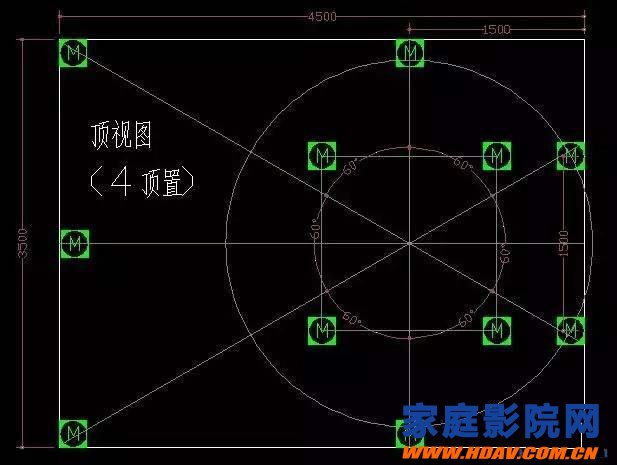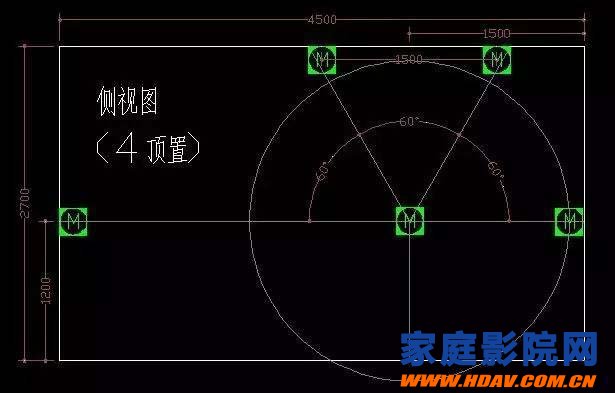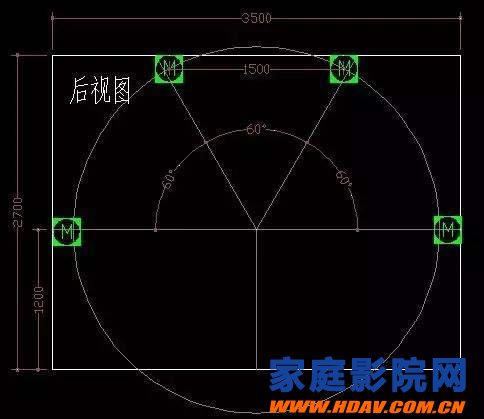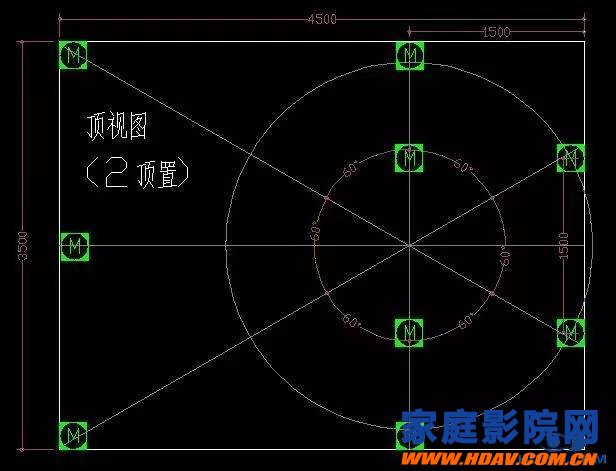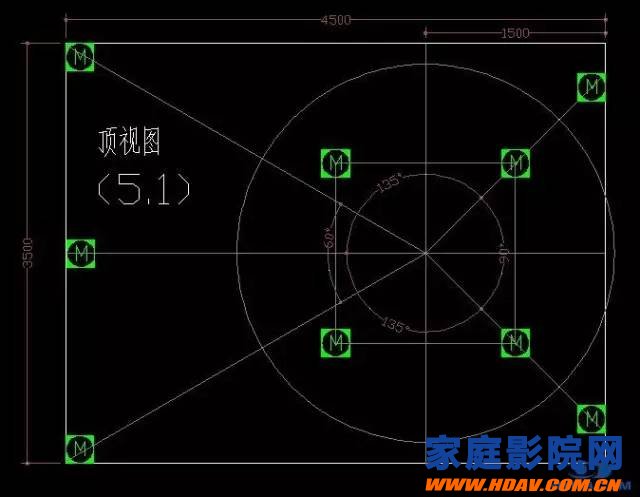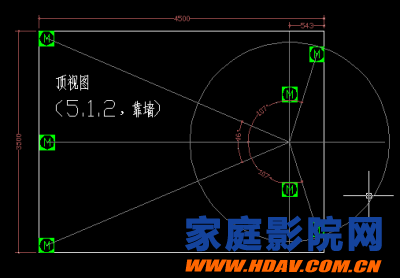[Home Theater Network HDAV.com.cn] As the panoramic sound is getting hotter, more and more recent layout topics about panoramic sound speakers are now based on the Dolby panoramic sound white paper (original see attachment), combined with practical applications. , a system analysis of a speaker layout First, the layout articles Dolby has always installed the instructions for the speaker position, which emphasizes the correct position of the speaker. The accuracy of the position affects the final effect. The layout of Dolby Atmos is based on a global enclave centered on the listener. The only data that determines the correct position is the angle. The position of each speaker is laid out according to the white paper. The AV amplifier can be corrected. Listeners are separated by different time differences, but they cannot correct the transitional relationship errors caused by different angles, so remember one point: angle is the most important. When the AV power is used to render the transition and middle sound of the sound, the position of the sound is determined by the time difference of each speaker, and the basis of the time difference is that the speakers are equiangularly distributed. According to the angle of the original side, the panoramic sound layout of 7.1.4 is as follows: (The assumed room size is: 4.5 m x 3.5 m, 2.7 m high) As shown in the figure, the planar structure horns, except for the center, are distributed on an extension line of 60 degrees and other one week. Look at the side view again: Similarly, the main box and the overhead surround, equally divided into half a circle, the angle between each speaker is 60 degrees. Look at the relationship between the top and side rings: The angle between the speakers is still 60 degrees. If 2 ceilings are used, the layout is as follows: Use 2 overhead side views: Although the use of the overhead speaker is reduced, the overhead speaker is still equally divided between the front and the rear. Because the number and specific configuration of the power amplifier overhead speaker are explicitly indicated, the power amplifier will be correctly calculated during playback. Corresponding time difference to ensure the sound transition at the top is correct. The rear view with 2 overhead is the same as the 4 overhead: When the surround channel is reduced to 5.1.4, the top layout looks like this: It can be seen that the surround channel is reduced, and the surround channel position is moved to the middle of the original side ring and the rear ring. Also, since the number and configuration of the surround channels of the power amplifier are explicitly told, the power amplifier can also correctly restore the sound transition. And location information. Further reduction, the situation of 5.1.2 The above illustrations are based on the fact that the yarn is not against the wall. If the yarn is against the wall, it will not be able to satisfy all the angular relationships. The compromise of the plane around the circumference can only sacrifice the accuracy of the surrounding position, and try to retain the surrounding atmosphere. When the top channel is used with two overhead schemes, it can avoid the angle relationship of the vertical plane. Supplement: Many people have yarns against the wall, and can not achieve rear surround and 4 overhead. The recommended compromise 5.1.2 is as follows: (around the Jianyi use dipole to surround the wall) Second, the sound field image principle (positioning and transition) Multi-channel and two-channel stereo, the performance of the entire sound field is achieved by the principle of the image, but more speakers will participate in the activity, any adjacent speakers can be sounded through the horn body. The panoramic sound adds a z-axis dimension to the plane based on the addition of the overhead speaker, achieving a full-space full-frame positioning effect. The panoramic sound of the full-space sound target is positioned by the interaction between the overhead speaker and the surrounding one-time speaker to achieve precise positioning in all aspects, that is, the panoramic sound top information is not only emitted by the top speaker, but the top speaker and The result of other speaker knots. According to the vector principle of image synthesis, the top speaker can only achieve one image positioning with only one. Actually, more speakers (2 or 4) are used in the application, in order to get more at the lower layer height. Uniform overhead sound distribution. The transition and positioning of the sound object is the same, but the position is continuously changed. The transition between inertia and uniformity depends entirely on whether the angle relationship of the horn is correct. in conclusion: 1. No matter how many speakers are used at the top, it will not cause errors and loss of spatial positioning, only affecting the positioning accuracy and the smoothness of the transition. 2. Reflective speakers can't achieve the image, so only the panoramic sound effect can be achieved. Third, the direction of the speaker The direction of the horn has two meanings Horn orientation All Dolby built speakers are placed perpendicular to the wall, that is, horizontal and vertical, no need to face the audience 2. Speaker high and low position According to the principle of adjacent image, because the position and speed of the high and low sounds are different (phase difference), all adjacent speakers are distributed as axes symmetrically as much as possible to obtain better image results. and so: When two top speakers are used, it is better to use the speaker horizontally, and the high sound is directed to the left and right. (Fracture with the main box and the back surround image, the axis is vertical) When the four overhead speakers are used, it is better to use the horn vertically, and the treble is in the front and rear direction. (The image of the side surrounded by the side is removed, the axis is vertical) The overhead speaker can also choose a high-quality coaxial structure speaker to reduce the inevitable high and low bass phase error. About the height of the surround: Two statements: 1. Ear level 2. Slightly higher than the ear level My definition is 2, the specific height is also based on the angle, Dolby's standard is 0-15 degrees. The advantage of being slightly higher than the ear level is that when multiple people listen, the left and right people are prevented from hiding each other, and the human ear is not very sensitive to the height of the sound, and basically does not affect the positioning of the surrounding information. Comparison of 4, 2 overhead and 4 overhead Many fans, especially those who are ready to configure the panoramic sound, believe that the panoramic sound top must be the best of 4, even ignoring the installation conditions, hard-arranged four overhead, in fact, this is wrong. I combined with Dolby's speaker layout guidance and the above mentioned speaker position angle principle, I auditioned 5 cases in the field, the test content is mainly Dolby Test Disc 2, and listened to some panoramic sound source source fragments (such as Ninja / Jupiter Up), draw some conclusions: a. 5.1.2 (Anqiao 838/4 meter small hall / yarn hair against the wall) The top information of the panoramic sound is basically there, the surrounding transition is poor, the top information is poorly positioned, and the top information is excessively jumped. b. 7.1.4 (Anqiao 80.6/7 meter hall / two rows of yarn after the middle) The top information of the panoramic sound is correct, the surround transition is very good, the top information is positioned accurately, and the top information transitions smoothly. c. 7.1.2 (Pioneer LX88/4.5 meter hall / after the yarn is sent) The top information of the panoramic sound is correct, the surround transition is very good, the top information is positioned accurately, and the top information transitions smoothly. d. 7.1.4 (Anqiao 3030/5 m hall / after the yarn is sent) The top information of the panoramic sound is correct, the surround transition is good, the top information is correctly positioned, and the top information transitions smoothly. e. 5.1.2 (Pioneer LX58/4 meter hall / yarn hair against the wall) The top information of the panoramic sound is correct, the surrounding transition is good, the top information is correctly positioned, and the top information is well transitioned. Through the audition comparison of the above several cases, the ground surround integrity is more important than the overhead, which plays a big role in the transition smoothness of the playback, and the number of the overhead speakers does not affect the expression of the panoramic sound information: When two top speakers are used, the positioning information directly above can be better expressed, while the lateral transition is slightly blurred, but the sound positioning can be accurately indicated. When the four overhead speakers are used, the smooth movement of the sound can be better displayed, but the sound positioning on the upper side is slightly worse, and the multiple listening zones can be better balanced, so that the difference is not too large. in conclusion: According to your own room conditions, choose the appropriate panoramic sound layout, as long as the speaker is placed according to the standard position, there will be a good performance, there is no need to blindly pursue the speaker. Jianyi: Most of the fans in a single row of seats are better to choose the layout of 7.1.2. If the yarn is against the wall, it is preferred to choose the 5.1.2 layout. If there is a larger film and television hall and it is proposed to arrange a seat with more than 2 rows of seats, it is preferable to consider the layout of 7.1.4. More fresh and fun home theater information, please pay attention to home theater network http:// (WeChat: cnhifi), the country's most influential home theater audio player interactive media website. Note: This article is transferred from the new era of audio and video. The article is an independent view of the author and does not represent the position of the home theater network.
VersaMax
Micro and Nano Controllers
When you need an even greater productivity
boost, the Micro Plus controllers
are designed with the same high quality
as the Micro line of controllers, but have
enhanced features such as more memory,
high precision motion and an advanced
instruction set. They support a user friendly
Memory Module that can easily connect
to the controller to download the latest
program changes without the need of a
PC. Online programming enables the user
to easily modify logic without stopping the
controller. Flexible communications is also
the strength of the Micro Plus controllers
with both serial and Ethernet options.
Versamax Nano Plc,Versamax Nano Micro Plc,Ge Versamax Nano Micro Plc,Ge Fanuc Plc Versamax Xiamen The Anaswers Trade Co,.LTD , https://www.answersplc.com
